Posted by Anita on 06.03.09 6:19 PM
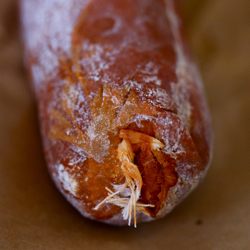 I first read about ‘nduja — a red-hot Italian meat paste that’s pronounced “en-DOO-ya” — in Saveur magazine, ages ago. Despite being the sort of foodstuff that’s right up my alley (hello, chiles and pork… together?!), I never seemed to be able to put my hands on the stuff. We’d heard rumors of a stall at London’s Borough Market selling ‘nduja, but our travels there never seemed to line up with their production. It seemed we’d have to make a trip to Calabria for the real thing, or go without.
I first read about ‘nduja — a red-hot Italian meat paste that’s pronounced “en-DOO-ya” — in Saveur magazine, ages ago. Despite being the sort of foodstuff that’s right up my alley (hello, chiles and pork… together?!), I never seemed to be able to put my hands on the stuff. We’d heard rumors of a stall at London’s Borough Market selling ‘nduja, but our travels there never seemed to line up with their production. It seemed we’d have to make a trip to Calabria for the real thing, or go without.
All that changed last month, with the introduction of locally made ‘nduja from Chris Cosentino’s Boccalone Artisan Meats. This spicy, spreadable salami’s quickly become the darling of the Bay Area carnivores, complete with an adorable nickname and mouth-watering coverage in all the hip spots.
But as delicious as it is when simply spread on a slice of baguette or a cracker, it seemed sacrilegious to snarf down such a long-sough treasure as an appetizer. Searching for other options, I came up with Gina DePalma’s very loose recollection of an ‘nduja-centric pasta dish she whipped up in her Roman kitchen. Despite not being much of a recipe — it lacked both measurements and timing cues — our first attempt at reproducing it turned out incredibly well, if I do say so myself. (You don’t have to take my word for it: Our friend Matthew, a former restaurant critic for the Seattle Times, pronounced it “as good as anything I had in a restaurant” during his visit to San Francisco.)
Now, I’m not sure I’d pick this humble pasta over an evening at SPQR or Contigo, but the dish was far more delicious than the effort it took to whip together. We nearly always have some dried pasta and a frozen container of leftover beans in the freezer; if I just keep a package of ‘nduja around, we’ll never lack a quick, weeknight supper.
The hardest part of the recipe may be getting your hands on the ‘nduja, which isn’t hard at all if you live in or near San Francisco: They sell it at the Boccalone Salumeria at the Ferry Building. For those of you farther afield, there’s always mail order (or a trip to Calabria?). Once you get your hands on the necessary ingredients, free to wing it with the ratios, just as we did. With such flavorful ingredients, I’m sure it’ll be just as good.
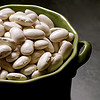
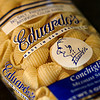
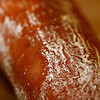
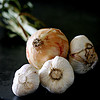
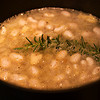
Pasta e Fagioli with ‘Nduja
– adapted from Gina DePalma
1 cup dry white beans
1 small onion, diced
olive oil
1 sprig rosemary
1 bay leaf
salt and pepper, to taste
1 carrot, peeled (if needed) and diced
1 stalk celery, chopped
2 cloves garlic, minced coarsely
4 oz (1/2 chub) cured ‘nduja, broken into chunks
8 oz dry small pasta, such as shells or ditalini
more olive oil, for garnish
hard Italian-style grating cheese, such as Pecorino
Soak the beans in enough water to cover by double their height, overnight if possible. When beans are soaked, heat a medium saucepan over medium-low heat; saute the onion in a good amount of olive oil until soft but not brown. Add the beans, their soaking liquid, rosemary, and bay. Bring to a hard boil for a few minutes, then reduce heat to a gentle simmer and cook until beans are beginning to become tender, but still firm. (This will take anywhere from 45 minutes to 3 hours, depending on the age of your beans and the length of their soaking.) Add the salt and pepper to taste, and simmer for another 10 to 15 minutes. At this point, you can discard the herbs and cool the beans in their liquid for later use.
When ready to bring the dish together: If you’ve made the beans ahead, gently warm them in their liquid in a small saucepan. Cook the pasta, stopping a minute or two before the cooking time on the package; drain and set aside. Meanwhile, heat a large skillet and add 2T olive oil. Saute the carrots and celery until soft; add the garlic and saute another minute. Add the ‘nduja, pressing to break it up and melt it as it heats. Add the beans and a small amount of their cooking liquid to the ‘nduja pan, along with the cooked pasta. If the mixture is dry, add more bean liquid until it’s wet; simmer a few minutes to allow the flavors to come together.
Divide the pasta into two or three warmed bowls. Drizzle with olive oil and top with shredded cheese.
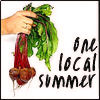
This recipe is our entry for the inaugural week of
One Local Summer 2009, hosted by
Farm to Philly, with Western Region posts graciously recapped by
Columbus Foodie. Just like
last year, we’ll be exploring and honoring the foods from our local farmers and producers with at least one meal each week made from 100% local ingredients. We’re not declaring any exemptions this time — other than salt and spices — and our radius will be 100 miles.
Farmers and food artisans who created the ingredients for this week’s meal:
Iacopi, Half Moon Bay: Italian butter beans
Catalán Family Farm, Hollister: Onions
Bariani, Sacramento: Olive oil
Star Route, Bolinas: Carrots
Chue’s Farm, Fresno: Celery and garlic
Boccalone, Oakland: ‘Nduja
Eduardo’s, San Francisco: Pasta shells
Joe Matos, Santa Rosa: St. George cheese
….plus rosemary and bay leaf from our garden
cooking, locavore, meat, One Local Summer, recipes
11 Comments »




Posted by Anita on 08.29.08 11:48 AM
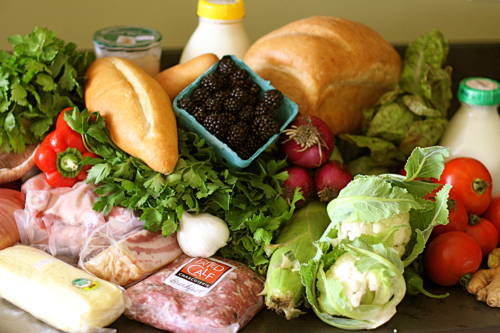
Our weekly shopping haul; One Local Summer, Week 13
—–
Unless you’ve been in a self-imposed media blackout, you may have heard about the party that Alice, Carlo, and friends are throwing here in Our Fair City. And you’d probably guess that a pair of diehard food dorks like us would be camped out in line, waiting for the chance to storm the gates first thing in the morning, wandering through the Victory Garden as we sample a continent’s worth of canapes in the dappled summer sun.
But the fact is, we live a Slow Food Nation life all the time. We spend practically every weekend grazing around the City and around the Bay Area. We live in a community where our oddball food choices have become fairly mainstream. We hang out with a crowd of thoughtful food-worshippers who can carry on a spirited debate about how to balance being a locavore with being a (small-c) chowhound.
We’re truly blessed to make our home here in the epicenter of the local, organic, sustainable food movement. San Francisco’s a city where it’s hardly a challenge at all to eat well and eat ethically… so much so that I get fairly bent out of shape when circumstances or travel force me to do otherwise.
So, no — No “Foodstock” for us. Happily, we have a lot to do this weekend:
– Buying our weekly groceries from the people who grow/make them
We do this every week at the Ferry Plaza Farmers Market, but just to make it interesting — and to bypass the frenzy of out-of-town foodies descending there this weekend — we’re heading across the bay to the Berkeley Farmers Market. We’ll see some of our usual vendors there, but I’m looking forward to exploring new stalls and new ingredients.
– Putting up food to preserve the harvest
Later in the day, we’ll pick up 100 pounds of San Marzano tomatoes at Mariquita Farm’s “guerilla veggie” drop-off. Later in the weekend, we’ll be hauling out the pressure canners and turning them into puree, marinara sauce, and whole canned tomatoes to feed us through the winter
– Supporting restaurants that support local farms
Mariquita’s making their drop at Piccino, so we’ll have a chance to experience their brunch for the first time. The fact that Sher and Wayne — like so many other San Francisco restaurateurs — procure so much of their raw ingredients from the same farmers and artisans that we buy from makes me inexplicably giddy.
– Exploring the food traditions of our neighbors
Saturday night, we’re heading out to a family-run ethnic restaurant with a group of food-obsessed friends. Later in the weekend — if we get our canning done — we’ll visit a Thai food festival put on by the local Buddhist temple at Golden Gate Park. Neither of these experiences are Slow, in the sense of using exclusively sustainable/local/organic ingredients, but supporting ethnic foodways is an essential part of being a citizen of our city and the world.
– Celebrating the bounty of our region
On Monday, we’re having some friends over for a little nosh. We’ll eat some pâté and peaches, sharp cheese and homemade plum chutney. We’ll drink local bubbly, sip homemade pear brandy, maybe even shake up a cocktail using artisanal spirits. Later there’ll be farmers-market pasta tossed with some of the marinara sauce we made earlier, maybe baguette slices spread with pesto. A pie, perhaps… made with a local-flour-and-butter crust (learned from a friend who also happens to be a local treasure) and filled with yet more amazing farmers market finds.
—-
 Am I conflicted about opting out of the Slow festivities? Absolutely. I’m already drooling over the Slow on the Go and Taste Pavilion tidbits showing up in friends’ Flickr streams. By all accounts, the Friday events have been beautiful, interesting, and delicious. I hope that they keep it up, because the people who’ve traveled here from all over the world deserve it. And so do the farmers, food-makers, and volunteers who are going all-out to make a fabulous impression.
Am I conflicted about opting out of the Slow festivities? Absolutely. I’m already drooling over the Slow on the Go and Taste Pavilion tidbits showing up in friends’ Flickr streams. By all accounts, the Friday events have been beautiful, interesting, and delicious. I hope that they keep it up, because the people who’ve traveled here from all over the world deserve it. And so do the farmers, food-makers, and volunteers who are going all-out to make a fabulous impression.
But on the other hand, I know we’ll make the perfect slow celebration, in all the ways that matter most to us, just as the folks visiting our city and our local producers will have theirs. Either way, I can’t think of a better way to celebrate Labor Day than by honoring the backbreaking effort — both physical and political — that our farmers and artisans spend to put quality food on our tables.
Bay Area, farmers markets, locavore, One Local Summer
18 Comments »




Posted by Anita on 08.24.08 6:08 PM
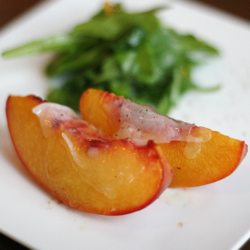 Aside from grinding and stuffing a few pounds of sausage now and then, curing meats is a task — much like beer-brewing and bread-baking — that I am more than happy to leave to the experts. Don’t get me wrong: I love getting up to my elbows in fatty meat and curing salts and aromatics. But when you have local artisans like Fatted Calf, even the most enviable meat-curing skills become obsolete.
Aside from grinding and stuffing a few pounds of sausage now and then, curing meats is a task — much like beer-brewing and bread-baking — that I am more than happy to leave to the experts. Don’t get me wrong: I love getting up to my elbows in fatty meat and curing salts and aromatics. But when you have local artisans like Fatted Calf, even the most enviable meat-curing skills become obsolete.
To say we’re big fans of the work that Taylor Boetticher, Toponia Miller, and the rest of the Fatted Calf crew are doing is a huge understatement. We’ve spent the last two years gleefully eating our way through their entire offering, and there’s barely a thing we’ve tried that didn’t make us squeal with delight. Their smoky bacon is heaven in a frying pan, their rind-on pancetta is nothing short of funky-fabulous. Their beef jerky is addictively awesome, and their pâtés and terrines are a slice of savory joy. Their sausages — especially the Toulouse and the andouille — are light-years better than anything we make at home.
So when we heard that Piccino — a jewelbox cafe/restaurant in Dogpatch, the next neighborhood over — was hosting a supper featuring Fatted Calf products, cooked jointly by Taylor and the Piccino crew, we reserved two slots as fast as our little fingers could email the RSVP.
I should add at this point that Cameron and I have mostly given up on these sorts of one-night foodie extravaganzas. It’s too easy to get your expectations set impossibly high, or to calibrate each bite to the fantastic sum of money you’ve spent. We went against our usual stance this week for two reasons: Piccino is precisely the kind of restaurant we love — a cozy neighborhood space with a short, ingredient-driven menu that actively supports local farmers and food artisans — and because we can’t get enough of Fatted Calf.
On the night of the meaty meal, we gathered on the sidewalks in front of Piccino’s corner doorway. Happy gaggles of diners shunned the interior and spread down each street, glasses of deep-pink rosé in hand as we savored a rare, warm San Francisco summer evening. We hung back for another reason, too: We weren’t sure how we would all fit into the small dining area. Eventually, we were called to the communal table, so we squeezed onto the banquette, tried not to knock elbows with our neighbors, and wondered just what we’d gotten ourselves into.
We needn’t have worried. By the time the second course (and third glass of wine) rolled around, we’d been utterly, completely won over. There were some service mishaps — one end of the table missed out on a pizza that somehow got misdelivered not once but three times — but these were forgivable, almost-funny oversights. We were chatting with our neighbors quite amiably by this point, companionably sharing platters of assorted charcuterie and a casuela full of lightly pickled, jewel-like vegetables.
 For the next course, we each got our own plates… a wise move, as I suspect that riots might have broken out otherwise. Who could be trusted to share a perfectly ripe Hamada Farms peach, draped with tissue-thin lardo, accessorized with a bitter-crisp salad of baby dandelion greens? (Hint: Not me.) Next up came an inspired riff on pork and beans: Shelling beans cooked to a toothsome creaminess, garnished with crisp-chewy pork rillons and melted Early Girl tomatoes.
For the next course, we each got our own plates… a wise move, as I suspect that riots might have broken out otherwise. Who could be trusted to share a perfectly ripe Hamada Farms peach, draped with tissue-thin lardo, accessorized with a bitter-crisp salad of baby dandelion greens? (Hint: Not me.) Next up came an inspired riff on pork and beans: Shelling beans cooked to a toothsome creaminess, garnished with crisp-chewy pork rillons and melted Early Girl tomatoes.
Then, the main course platters filled the table: unctuous smoked lamb; bowls of fregola with charred young onions and baby potatoes; marinated eggplant with roasted gypsy peppers and capers; golden beets with their own sauteed greens, tarragon, and ricotta salata; and an out-of-this-world mint chutney. After hours of joyful din, passed platters, copiously refilled glasses, and a bevvy of spontaneous toasts to the kitchen, we were struck dumb. Everyone, all down the table, sat nearly silent, in awe of the fabulous food.
We hardly had room for dessert, but we bravely soldiered on. Plates of figs in various stages of caramelization arrived, dolloped with sheep’s milk fromage blanc, decorated with strawberries, and accompanied by an almond tuile. We lingered in the candlelight, talking with new acquaintances and exchanging plans to run into one another at the market next weekend. When I looked at my watch, I was stunned to see it was nearly midnight: We’d passed 5 hours in a magical space that somehow seemed to have grown larger, filled with conversation, light, and laughter.
To me, the most amazing thing about the whole meal was that (with the exception of the fregola and the wines) everything we ate came from within our local foodshed. The lamb was grown on the same Napa homestead as the shelling beans, both brought to Taylor as part of an over-the-fence trade with a prolific neighbor. Like all of Piccino’s regular meals, the vegetables and fruits for the evening were sourced from local farmers; many of their names graced the menu.
Although this was a one-time event, we’re already looking forward to going back to Piccino often. (I’ve stopped in a few times for a glass of wine and a bite to eat after picking up my Mariquita mystery box, but I haven’t really tried a whole meal there. That’s going to change.) And, if you’re in the mood for an epic food evening like ours, check out the Piccino schedule; there’s another meat dinner scheduled with RoliRoti’s Thomas Odermatt in October, and a mushroom feast with Far West Fungi in November.
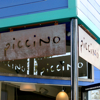

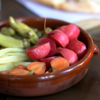
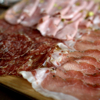

Piccino Café and Pizzeria
801 22nd Street
San Francisco, CA 94107
415/824-4224
Fatted Calf Charcuterie
Oxbow Public Market
644-C First Street
Napa, CA 94559
707/256-3684
– Also sells most products at:
Berkeley Farmer’s Market
Saturday, 10 to 3
Ferry Plaza Farmer’s Market
Saturday, 7:30 to 2
locavore, meat, Napa & Sonoma, One Local Summer, restaurants
10 Comments »




Posted by Anita on 08.17.08 4:00 PM
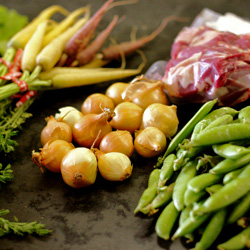 Compared with other parts of the country, most of the Bay Area’s food-growing regions benefit from amazingly temperate climates. Our summers here are so mild that we never really lose our early crops. We’re able to buy all those little springtime dainties — sugar-snap peas, baby carrots, and tiny onions — deep into August.
Compared with other parts of the country, most of the Bay Area’s food-growing regions benefit from amazingly temperate climates. Our summers here are so mild that we never really lose our early crops. We’re able to buy all those little springtime dainties — sugar-snap peas, baby carrots, and tiny onions — deep into August.
It’s a little joke of nature, of course, because the summer months in San Francisco feel like the worst parts of everyone else’s schizophrenic spring. You know that “in like a lion, out like a lamb” effect that people ascribe to March? Well, here we get it all in a single August weekend. Repeatedly.
For every warm and sunny Sunday where all you want is a summer supper of insalata caprese and a nibble of grilled chicken, there are twice as many foggy, grey Saturdays where something a little more substantial is in order. Not that we’re hauling out the cassoulet or anything, but our summertime cold snaps are so inevitable that we almost always plan a stew or braise each week, to haul out when the fog rolls in.
But even when the mercury dips down into the 40s, I have a hard time getting behind ultra-heavy dinners. The nights are still short, after all, and we’ve probably had at least a glimpse of sun during the day. So I prefer a compromise; a stew that’s almost spring-like, with a lighter air about it.
In France, you’d probably serve a lighter braise like the one we made this week in springtime, with a glass of rosé and a loaf of crusty bread. But, socked in by fog so dense we could barely see the neighbors’ yard, we opted for a pile of mashed heirloom potatoes and a half-bottle of local Syrah.
The good news is that the best is yet to come: The true beauty of San Francisco weather is our Indian Summer. When the rest of the world is gearing up for deep autumn, our farmers will still be pulling in corn, tomatoes, and all the other high-summer crops. But for now, while we slip on our sweaters, a stew will do.





Navarin Printanier — Braised Lamb with Young Vegetables
1 large thyme sprig
1 rosemary sprig
1 bay leaf
6 whole black peppercorns
2 pounds lamb stew meat
olive oil
1 small onion, small dice
3 cloves garlic, minced
1 cup dry white wine
2 cups beef stock
12 pearl onions
1/2 lb baby carrots, trimmed and scrubbed
1/2 lb sugar snap peas, trimmed
2 T unsalted butter (room temperature)
3 T all-purpose flour
Preheat oven to 300°F. Put the rosemary, thyme, bay leaf, and peppercorns in an infusing ball, or tie into a square of cheesecloth.
 Trim the stew meat of all excess fat, and cut into 2-inch pieces; season with salt and pepper. In a 4-quart pot, heat enough olive oil to coat the bottom of the pan, and brown meat in as many batches as needed to keep from crowding the pan. As each piece becomes well browned, remove it to a bowl with tongs or a slotted spoon. Continue with remaining meat, adding more oil as needed.
Trim the stew meat of all excess fat, and cut into 2-inch pieces; season with salt and pepper. In a 4-quart pot, heat enough olive oil to coat the bottom of the pan, and brown meat in as many batches as needed to keep from crowding the pan. As each piece becomes well browned, remove it to a bowl with tongs or a slotted spoon. Continue with remaining meat, adding more oil as needed.
After all meat is cooked and resting, add onions to the pan. Cook over medium heat until softened and beginning to color. Add minced garlic and continue to cook until onions are golden. Add the wine and the stock, scraping the bottom of the pan to loosen any browned bits. Return the meat and its juices to the pan, along with the herb ball. Bring to a simmer on the stovetop, then cover and put in the preheated oven for 60 to 90 minutes.
While meat is braising, prep the vegetables. Place a large bowl two-thirds full of ice and water near the stove. Bring a large pot of salted water to a boil, and cook the unpeeled pearl onions until tender; timing will vary greatly depending on size and freshness of your onions. When tender, remove with a slotted spoon to the ice-water bath to cool, reserving the boiling water. Parcook the peas next, and remove to the ice-water bath when cooked through but still bright and snappy. Finally, parcook and chill the baby carrots. When all vegetables are cooked, drain them in a colander. Peel the onions, being careful not to remove too much of the root, and set aside with the rest of the vegetables until lamb is cooked.
When the meat is just tender but not falling apart, return the pan to the stove over medium-low heat. Adjust seasonings with salt and pepper, then scoot the meat to one side of the pan. Stir together the butter and flour to make a paste, and add it, bit by bit, to the simmering braising liquid to thicken the juices to a gravy-like consistency; you may not need all of the paste. When you get the thickness you like, stir the meat back into the sauce and simmer for another 2 minutes to allow the flour to cook out. Add the vegetables to the pan, and cook just until heated through. Adjust again for salt and pepper, and serve.
locavore, meat, One Local Summer, recipes
5 Comments »




Posted by Anita on 08.10.08 8:22 PM
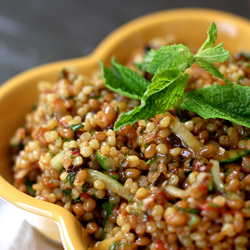 After a whirlwind month of travel, it sure feels good to be home. Even though I was painfully aware of the time we’d spent away from our own kitchen, I hadn’t really grasped how long we’d been absent from the farmers market. Despite our well-planned list, we wandered around the Ferry Plaza in a full-blown daze, like tourists who’d never seen produce before. But our farmers seemed genuinely happy to see us, and the usual summer bounty looked more glorious than ever to our newly appreciative eyes.
After a whirlwind month of travel, it sure feels good to be home. Even though I was painfully aware of the time we’d spent away from our own kitchen, I hadn’t really grasped how long we’d been absent from the farmers market. Despite our well-planned list, we wandered around the Ferry Plaza in a full-blown daze, like tourists who’d never seen produce before. But our farmers seemed genuinely happy to see us, and the usual summer bounty looked more glorious than ever to our newly appreciative eyes.
But somehow — even though we returned home with armloads of the most beautiful food on the planet — our first real meal back home didn’t translate into a fabulous feast. The occasional lackluster supper is bad enough when you’ve put an afternoon of thought and effort into it, but when you’re having company over to boot… ugh.
We turned some of our meat CSA haul into homemade sausage using Ruhlman’s merguez recipe. The test patties we made tasted fine, but an afternoon of fridge-rest made the coils taste blah, not bright. Somehow a Turkish-style soup of tepary beans and cumin — which I’ve made before and loved — turned into a stodgy mess.
For dessert, we harvested three beautiful bergamots off our tree to make champagne-citrus sorbet. But when we cut the fruits open, they were nearly all pith. Desperately squeezing them anyway while praying for a food miracle, we got less than half the juice we needed. We punted and bought a replacement carton from Whole Foods, and served it alongside locally made baklava.
But luckily, despite all the other disappointments, our side dishes turned out pretty well. On the grill alongside the mergez, we roasted skewers of multicolored sweet peppers from Quail Hollow and purple onions from Catalan. And even though it looked a bit like leftover hot cereal, a salad of Full Belly Farms wheatberries — dressed with local vegetables and our own garden herbs — was the best thing we ate all night.
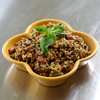
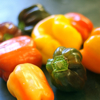
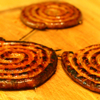
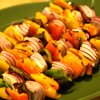

Wheatberry Salad
– adapted from Epicurious
1 cup wheatberries
1 red bell pepper
1/4 cup olive oil
2T fresh lemon juice
1T red-wine vinegar
1 tsp ground cumin
2 cloves garlic, minced
2 tsp coarsely ground aleppo pepper (or to taste)
3T minced parsley
3T mint chiffonade
2 ounces feta, diced small
1/2 cup thinly sliced red onion
1/2 English (or other seedless) cucumber, cut into julienne strips
2T to 1/4 cup chopped brine-cured black olives
 Soak the wheatberries overnight, or for at least a few hours. Cook the berries in a large pot of boiling salted water until tender but not blown out, about 2 hours. (Depending on freshness, wheat variety, and soaking time, this can take as little as an hour or up to 3 hours.) When cooked, drain the berries and set aside.
Soak the wheatberries overnight, or for at least a few hours. Cook the berries in a large pot of boiling salted water until tender but not blown out, about 2 hours. (Depending on freshness, wheat variety, and soaking time, this can take as little as an hour or up to 3 hours.) When cooked, drain the berries and set aside.
Meanwhile, roast the red pepper and place in a brown bag or covered bowl to steam soft, about 20 minutes. When cool enough to handle, remove the skin and seeds, and slice the flesh into long, narrow strips.
In a large bowl, whisk together the olive oil, lemon juice, vinegar, cumin, garlic, aleppo pepper, and salt to taste. Add the cooked wheatberries and stir well to coat; toss in the remaining ingredients. Taste for seasonings and adjust if needed. Serve immediately at room temperature. (You can also refrigerate as needed, but the salad will be stickier. Be sure to remove from the fridge about 30 minutes before serving to take off some of the chill, and toss again to refresh the appearance of the dish.)
entertaining, locavore, One Local Summer, recipes
8 Comments »




Posted by Anita on 08.04.08 8:39 PM
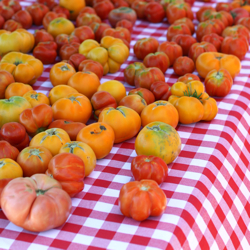 Once upon a time, Southern California was an agrarian epicenter where even small back yards usually boasted a mini-orchard, bursting with citrus or stone fruit.
Once upon a time, Southern California was an agrarian epicenter where even small back yards usually boasted a mini-orchard, bursting with citrus or stone fruit.
My father’s parents lived in semi-rural Monrovia, on a plot that included chickens, a kitchen garden, and a small avocado orchard that Dad tended to earn his allowance. Mom’s parents lived in suburban Glendale, but even their yard was full of edible options, including an enormous orange tree that we harvested for fresh-squeezed juice. As late as the 1980s, there were were actual citrus groves still supplying fruit for roadside stands near my childhood home in Orange.
But these days, urban blight and suburban sprawl have plowed under this once-fertile landscape; the names of streets and boulevards offer the last hint of the area’s pastoral past. Sadly, you’ll find no nuts on Nutwood, no oranges on Orangethorpe, no chiles in Anaheim. A few last pocket farms remain, but by and large they’re limited to mono-crops like strawberries or pumpkins… the kinds of u-pick items that scout troops and school groups will pay to see.
As you might imagine, an area this divorced from its farming heritage makes for a pretty tough locavore life. Despite a few large, well-regarded farmers markets, even the notion of a dedicated farm-to-table restaurant is pretty out on the fringe. LA Weekly–überfoodie Jonathan Gold laments that “the idea of locavore dining is more admired than actually practiced in Los Angeles, even at the restaurants where farmer-celebrities like Alex Weiser or the McGraths are treated with more awe than Matt Damon.”
For home cooks, local produce is widely available so long as your schedule and location make it easy for you to visit the bigger farmers markets in Irvine, Hollywood, or Santa Monica. But if you’re not able to shop on Saturday, you’re pretty much stuck with food of unknown origin. During our recent trip to the area, we rented a vacation house with my family for the week, and so we had access to a kitchen. But we got into town too late to hit the farmers markets… a mistake we will be sure not to repeat!
Much like the supermarkets back home in Northern California, none of those we visited in Los Angeles or Orange County offered any indication of where their food came from. Even Whole Foods was a joke: Items bottled in Napa Valley — at the other end of the state — were proudly labeled as “LOCAL!”. When we asked employees about this, they pointed out Whole Foods’ store policy: Anything raised within 7 hours of the market was considered local… perhaps the most liberal interpretation of locavorism that I can imagine. And although we’re used to having to pay close attention to sourcing even at our local Whole Foods, we were surprised that we didn’t see a single ‘local’ sign in the produce section.
But it was Henry’s Marketplace — part of the Wild Oats chain — that won the hypocrisy prize: A giant banner on the rear wall of the store read: “Choose LOCAL! Enjoy the freshest flavors from your community.” But in fact, the only local products we were able to find in the entire store were Broguiere’s milk (locally processed from semi-local, non-organic herds) and Henry’s own-brand eggs. Not a single fruit or vegetable bin was labeled with its point of origin, much less its farmer’s name.
 After much searching, we stumbled upon the website for South Coast Farms, one of Orange County’s last small-scale farm operations. We took a trek down Coast Highway to find that they do run a daily farm stand with a remarkably diverse set of offerings… our first clue that something wasn’t quite right. Turns out, only a handful of the items for sale are actually grown on site: Tomatoes, cucumbers, onions, and a few herbs. Others are ‘local’ — alas, no indication on signs of farms or even towns — and many are simply big-organic imports from South America. (Apparently, their CSA is a little more focused than the stand.)
After much searching, we stumbled upon the website for South Coast Farms, one of Orange County’s last small-scale farm operations. We took a trek down Coast Highway to find that they do run a daily farm stand with a remarkably diverse set of offerings… our first clue that something wasn’t quite right. Turns out, only a handful of the items for sale are actually grown on site: Tomatoes, cucumbers, onions, and a few herbs. Others are ‘local’ — alas, no indication on signs of farms or even towns — and many are simply big-organic imports from South America. (Apparently, their CSA is a little more focused than the stand.)
Working on a tip that Cal Poly Pomona offered local meat processed by their students, we took a trip out to the Farmstore at Kellogg Ranch. We did find local protein, but frozen chickens and a few sausages were all that the cases held. (Perhaps the stock is better during the school year?) Once again, it was anyone’s guess whether the fruits and veggies on offer were grown locally; there were a number of out-of-season crops for sale that made us suspect not. We got all excited over an entire wall of preserves, pickles, and sauces in quaint Mason jars, until we naively asked the store manager whether they were made by students, or just made from the farm’s own crops. “Oh, no…” she replied, with a tone that implied we’d just rolled off the turnip truck, “We just buy them from a company that puts our label on them.”
Defeated, we stopped into one of the smaller weekday farmers markets to see what we could cobble together. Although there couldn’t have been more than a dozen stalls, the mostly-Latino farmers offered a nice assortment of options: A basketful of tomatillos, a few heads of pungent celery, brown bags of fingerling potatoes, a huge pile of frying chiles, stacks of whiskery onions. Nobody seemed to be indulging in the luxury of specialization, which suited us just fine.
I won’t even go into the afternoon we spent trying to find local rolls for our sausages, but suffice to say we succeeded — even though we bought squishy commercial hoagie buns from the supermarket. A tiny corner store near our beach house supplied us with locally made tortilla chips, which we ate dipped in salsa verde made entirely from farmers market vegetables. For our entrees, we grilled up the German-style bratwurst we’d found at Cal Poly, topped them with a sauteed mix of peppers and onions, and served them on those supermarket buns. On the side, we had our favorite potato salad — everything locally sourced except the mayo and spices… and pickles from one of Kellogg Ranch’s faux-local canning jars.
Of course, it took us all week to get everything we needed, and our carbon footprint was enormous: We took the 100-Mile Diet to a literal extreme, racking up 90+ miles in the car on our search. I’m sure that with a little practice and a lot of hunting, we could find easier sources for much of what we drove around to find. But I’m thankful, more than ever, for the bounty that sits literally at my doorstep in San Francisco.
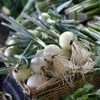
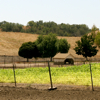
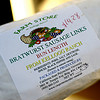
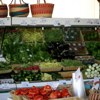
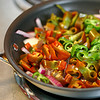
South Coast Farms
32701 Alipaz Street
San Juan Capistrano, CA 92675
(949) 661-9381
Monday through Saturday 9am to 5pm; Sundays 9am to 4pm
The Farmstore at Kellogg Ranch
4102 S. University Drive
Pomona, CA 91768
(909) 869-4906
Sunday through Friday 10am to 6pm; Saturday 8am to 6pm
Tustin Farmers Market
Corner of El Camino Real and 3rd Street
Tuesdays, 9am to 1pm
locavore, One Local Summer, SoCal
16 Comments »




Posted by Anita on 07.27.08 10:08 PM
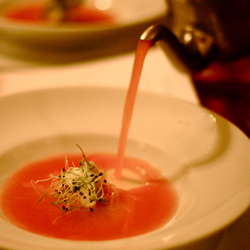 One of the hardest things about traveling is coming home to an empty fridge. Even back when we mostly shopped at the supermarket, this was one of the worst parts of any vacation. But now that we buy nearly all of our food at the farmers’ market, we’ve added a level of complexity to the mix.
One of the hardest things about traveling is coming home to an empty fridge. Even back when we mostly shopped at the supermarket, this was one of the worst parts of any vacation. But now that we buy nearly all of our food at the farmers’ market, we’ve added a level of complexity to the mix.
Luckily, we have a really nice Tuesday lunchtime farmers market at the Ferry Plaza; it’s much smaller than the Saturday showplace, but there’s just enough diversity to re-stock for a few midweek meals, especially if you hit up the indoor shops for meat and bread. So, our 100% local meal this week for One Local Summer included a Range Brothers pork chop dusted in Eatwell rosemary salt, Eduardo’s fusilli with Spring Hill butter, and some Iacopi Farms romano beans… a simple slice of summer.
But honestly, the foods we really wanted to be eating were back in New Orleans, where we spent the last week. Perhaps the feast of the week was our Spirited Dinner at Restaurant August, where chef John Besh created a mostly local, entirely seasonal menu with cocktail pairings by Charlotte Voisey, brand ambassador for Hendricks Gin.
Here’s the menu (and links to photos):
- Chilled melon “soup and salad” local charentais, watermelon, and Vietnamese herbs
- Belle River crawfish agnolotti with Allen Benton’s bacon, Honey Island chanterelles, and sweet fava beans
- Seafood-stuffed breast of local veal Silver Queen corn and crab risotto
- Heirloom tomato tarte tatin with creme fraiche ice cream
It was all quite lovely (well, perhaps excepting the dessert, which was much more interesting in concept than in execution) and it was fun to experience locavore life in another part of the country, where asparagus and favas are still in season, and crayfish — not crab — are fresh and plentiful. But honestly, as delicious as the high-falutin’ food was, it wasn’t very novel. Other than those crayfish, there wasn’t much that couldn’t have made an appearance at a Bay Area restaurant of August’s caliber. No, the true treasures of New Orleans’ local food scene were neither organic or sustainable.
 The Crescent City’s culinary delights are the stuff of legend. Even if you’ve never been to New Orleans, you’ve probably read of the glories of beignets and chicory coffee at Cafe du Monde. I’m sure you’ve heard of Central Grocery‘s legendary muffulettas, and the po-boys at places like Mother’s or Johnny’s. You might even have seen photos of Hansen’s Sno-Bliz, the world’s most perfect frozen delights, the kind of snow cones they might serve in heaven.
The Crescent City’s culinary delights are the stuff of legend. Even if you’ve never been to New Orleans, you’ve probably read of the glories of beignets and chicory coffee at Cafe du Monde. I’m sure you’ve heard of Central Grocery‘s legendary muffulettas, and the po-boys at places like Mother’s or Johnny’s. You might even have seen photos of Hansen’s Sno-Bliz, the world’s most perfect frozen delights, the kind of snow cones they might serve in heaven.
But as lovely as these made-to-order treats are, even the local stuff that comes in bottles and boxes tastes better in N’awlins than whatever it is you have at home. And nobody ever tells you about them! So let me be the first to suggest — nay, insist — that when you visit New Orleans, don’t miss out on some local treasures that can actually make the trip home with you.
Closest to my heart are Zapp’s — a brand of locally made potato chips that taste like a cross between Kettle Chips and manna from heaven. (And I bet you can’t find flavors like Spicy Cajun Craw-Tater, Dill Gator-Tater, or Spicy Creole Tomato back home.) Wash your chips down with a bottle of Abita amber beer, or a Barq’s root beer in the painted-label bottle… both of which taste much better in Louisiana than they do when you happen to run across them elsewhere.
Later, when your appetite comes back, make sure to find a Hubig’s pie or two. The closest analog is those Hostess ‘fruit pies’ you might have eaten as a kid, but they’re so much better that the comparison is entirely inadequate. No high-fructose corn syrup or hydrogenated soybean oil here, just beef fat and pure southern sugar. Their fruit fillings are made from actual fruit and sugar, not chemicals and essences. Tuck one in your carry-on bag for the flight home, and you’ll be the envy of your seat mates for sure.

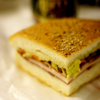
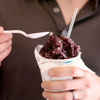


More New Orleans photos and notes on Flickr…
Spirited Dinner: At restaurant August, with cocktail pairings
Central Grocery: Muffulettas, Abita amber, and Zapp’s chps
Cafe du Monde: Beignets and chicory coffee
Mother’s: Ferdi po-boy (ham and ‘debris’)
Johnny’s Po-Boys: Crawfish po’boys, Cajun sausage po’boys, Barq’s root beer
Hansen’s Sno-Bliz: The best snow-cone treats in the cutest little shack
More New Orleans photos: Emeril’s, Tales sessions, Quarter scenery, and more
locavore, New Orleans, One Local Summer, restaurants
6 Comments »




Posted by Anita on 07.16.08 11:39 PM
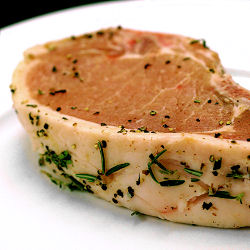 I have to say right up front, I never was a big fan of the whole brining craze. I mean, yeah, sure — you pump a turkey or chicken full of salt water, and it stays moist… but the white meat ends up with all the texture of an old sponge.
I have to say right up front, I never was a big fan of the whole brining craze. I mean, yeah, sure — you pump a turkey or chicken full of salt water, and it stays moist… but the white meat ends up with all the texture of an old sponge.
Some pundits (and yes, I’m looking squarely at you, Chris Kimball) prescribe brining as a panacea for nearly every meat, and a few types of seafood, too. But, really, why not start out with a nice piece of meat to begin with and treat it right? After a few squishy suppers, I learned my lesson: Whenever I see “brined” on a menu or in a recipe, I cross it off my list.
But our dinner last week at Nopa got me thinking again. I ordered the justly famous pork chop, and it was everything pork should be, but seldom is: Meaty, juicy, chewy, and flavorful. As I raved to our server, she explained that the delicious Napa-raised pork they use doesn’t need much help. But then she added that a quick 4-hour brine helps boost the flavor so that every bite is seasoned, without turning the texture to wet-paper-towel consistency.
A chop this good is enough to make a brining convert out of even a curmudgeon like me. Determined to repeat the brined chop at home, I turned to the cookbook from the last restaurant where I really remembered being wowed by a pork chop. And wouldn’t you know it: They quick-brine their pork at Boulevard, too. The original recipe calls for making a brine with hot water, then chilling it in the fridge before adding the meat. But I’m lazy and I need to keep moving on the weekends or else nothing gets done. So I cut back on some of the liquid in the dissolving step, and added it back in — in the form of the chicken-stock cubes we keep on hand for sauce-making — to cool the brine in an instant. (If you don’t keep your extra stock in ice cube form, you can always use plain old ice.)
Into the briny deep went a gorgeous Marin Sun Farms chop — a good, thick one we picked up at the farmers market. After its bath and a subsequent drying-out rest in the fridge, we grilled it over medium heat, to avoid scorching the exterior. On the side, we roasted some of Mr. Little’s gorgeous fingerlings in a mix of Spring Hill butter, Sciabica olive oil, our own herbs, and a healthy scattering of gorgeous young Rocambole garlic. We made a pan of Dirty Girl haricot verts using our favorite stovetop method and enjoyed the lot with our pairing this week: Fox Barrel hard cider, the same as we used in the brine.

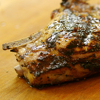
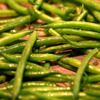

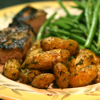
Quick-Brined Pork Chops
– adapted from Boulevard: The Cookbook
1 cup hot water
2T kosher salt
1/4 cup packed brown sugar
1/2 cup hard cider
1T crushed black peppercorns
1T Dijon mustard
5 sprigs thyme
2 tsp chopped fresh rosemary leaves
1/2 cup unsalted chicken stock, frozen (or crushed ice)
2 thick-cut pork chops
Combine the water, salt, and sugar in a large bowl or glass measuring cup, stirring until the salt and sugar dissolve. Add the cider, peppercorns, mustard, thyme, rosemary, and frozen stock. Stir the brine until the stock melts; if still warm, refrigerate until cool.
Put the chops in zip-top bag, and pour the cooled brine over them. Seal the bag, squeezing out as much air as possible. Put the bag in a bowl or glass pan, and arrange or prop up the chops so that they’re standing edgewise. (You want the brine to be in contact with both of the cut sides of the chop. In my small mixing bowl, I can put the chops on their edge and lean them up against the side. If this isn’t possible, just be sure to flip them midway through the brining time.)
 Refrigerate the chops for 1-1/2 hours, or up to 4 hours — no more, or you will have mush. (And if you’re using thinner chops, an hour is plenty!) About 90 minutes before cooking, remove the chops from the brine, and pat dry. place on a plate (or, ideally on a rack over a rimmed baking sheet) in the fridge to dry out the surface a bit, and to allow the brine to equalize throughout the meat. 30 minutes before cooking, bring the chops to room temperature, and preheat your grill or oven. (Heat grill to moderate-high heat, oven to 375°).
Refrigerate the chops for 1-1/2 hours, or up to 4 hours — no more, or you will have mush. (And if you’re using thinner chops, an hour is plenty!) About 90 minutes before cooking, remove the chops from the brine, and pat dry. place on a plate (or, ideally on a rack over a rimmed baking sheet) in the fridge to dry out the surface a bit, and to allow the brine to equalize throughout the meat. 30 minutes before cooking, bring the chops to room temperature, and preheat your grill or oven. (Heat grill to moderate-high heat, oven to 375°).
When chops are at room temperature, season lightly with salt and pepper on both sides. To grill, cook in your usual fashion to medium temperature (140° to 150° before resting time) — timing will vary widely based on the thickness of your chops and the heat of your grill. If cooking in the oven, heat a large, oven-roof skillet over medium heat. (Brining does speed up browning, go a little cooler than you may be used to for searing meat.) When hot, add olive oil just to coat the pan; when hot again, add the chops and cook for 2 to 3 minutes, until golden, Turn the chops over, and move the pan to the preheated oven for 10 to 15 minutes.
When the meat reaches temperature — either on the grill or in the oven — remove from heat and let rest for 5 to 10 minutes. (If you finished in the oven, you can make a simple pan sauce.) Serve with your favorite seasonal accompaniments.
—-
* Edited to add: We removed the link to Cook’s Illustrated in protest of their bullying tactics.
locavore, meat, One Local Summer, recipes
8 Comments »




Posted by Anita on 07.13.08 6:58 PM
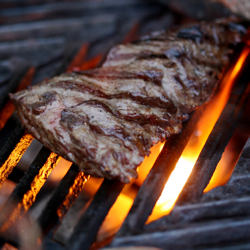 Last week, I went on about how miserably cold and foggy the weather had become. No sooner had I posted than the spell broke, and we traded arctic snap for heatwave. Would a day or two of mild, sunny but breezy weather be too much to ask?
Last week, I went on about how miserably cold and foggy the weather had become. No sooner had I posted than the spell broke, and we traded arctic snap for heatwave. Would a day or two of mild, sunny but breezy weather be too much to ask?
San Francisco proper was mercifully spared the full effects of the heat. But Cameron’s office down south was baking so hard that their air-conditioning conked out… at 9am! And friends of ours in Marin set up a kitchen on the back patio when the mercury passed 105°, making indoor cooking unthinkable. But the City stayed pretty mild, rising only to 85° on the hottest day, and cooling to manageable fan-free levels overnight.
In short, it was the perfect time to break out the grill.
Truthfully, we cook outdoors all year round here, even when the weather is grey. Our grill sits right out the back door of our kitchen, on a second-story deck overlooking the neighborhood and the bay beyond. It’s a pretty idyllic place to cook dinner, sipping a bottle of Speakeasy ale while gazing out at the view. We don’t need a lot of excuses to take our kitchen outside.
 And so last week, we found ourselves enjoying one of our favorite summer meals — carne asada tacos — cooked al fresco over a live fire. Dry-rubbed Marin Sun Farms flank steak, quickly seared and folded into Rancho Gordo tortillas, served with homemade salsas made from some of the best summer produce around. (Tomatillos and chiles are back, sweet onions are abundant, rocambole garlic is making its brief appearance, and cilantro is bolting in the garden like there’s no tomorrow.)
And so last week, we found ourselves enjoying one of our favorite summer meals — carne asada tacos — cooked al fresco over a live fire. Dry-rubbed Marin Sun Farms flank steak, quickly seared and folded into Rancho Gordo tortillas, served with homemade salsas made from some of the best summer produce around. (Tomatillos and chiles are back, sweet onions are abundant, rocambole garlic is making its brief appearance, and cilantro is bolting in the garden like there’s no tomorrow.)
We bought our first ears of corn this week, too — we always put off that purchase until we’re sure we’ll be getting high-season, super-ready ears. To give it a Latin flair, we roasted it on the grill and slathered it in chile-spiked crema, a gringo-style riff on a popular Mexican street snack. Truthfully, I think the creamy spread got in the way of the farm-fresh corn flavor — these ears were so fresh they were wet — but I’ll definitely make it again to help perk up less-than-perfect specimens, when the season’s winding down. It’d be a great way to give supermarket corn a kick, too, I suspect… something we’ll be able to test in a few weeks when we head to a family reunion in the Land of No Local Food.
Oh, and since we had the grill on? We roasted some homemade marshmallows and made semi-local s’mores, with Miette graham crackers and Scharffen Berger chocolate.
Ah yes, this summer is shaping up just fine after all.
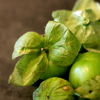



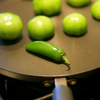
Grilled Corn with Chile Crema
– adapted from Bon Appetit, August 2007
4 T sour cream
1 tsp fresh lime juice
1/2 tsp red chile powder (ancho, chipotle, etc.)
pinch kosher salt
4 ears of corn, unhusked
3T chopped fresh cilantro (optional)
Preheat a gas or charcoal grill to medium heat. Remove outer husks from corn, leaving inner pale green husks attached. Gently fold back inner husks; remove corn silk. Wipe kernels with a tiny bit of oil, then sprinkle with salt and pepper. Rewrap inner husks, and grill corn until husks are charred and kernels are just heated through.
Pull husks back and place corn on a serving platter. Brush corn with spiced crema and sprinkle with cilantro (if desired).
locavore, One Local Summer, recipes
5 Comments »




Posted by Anita on 07.07.08 6:51 PM
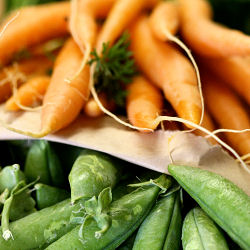 I know there’s some serious doubt about whether ol’ Samuel Clemens ever said “The coldest winter I ever spent was a summer in San Francisco.” But if he didn’t say it back in 18-whatever-it-was, he would definitely have said it this year. Because, hello, it’s been frickin’ cold over here. I keep hearing everyone else in the Northern Hemisphere talk about sweltering subway rides and temperatures too hot for grilling. Meanwhile, I’m hauling out the fleece and putting the sundresses back in the closet.
I know there’s some serious doubt about whether ol’ Samuel Clemens ever said “The coldest winter I ever spent was a summer in San Francisco.” But if he didn’t say it back in 18-whatever-it-was, he would definitely have said it this year. Because, hello, it’s been frickin’ cold over here. I keep hearing everyone else in the Northern Hemisphere talk about sweltering subway rides and temperatures too hot for grilling. Meanwhile, I’m hauling out the fleece and putting the sundresses back in the closet.
But, you know, if the weather is going to make it seem like winter, then who are we to second-guess Mother Nature? Our Marin Sun Farms Meat CSA box this month included a mega-jumbo chuck roast, way too large for the two of us to tackle in one sitting, even with leftovers. I hate to cut up a large hunk of meat, but — freezing weather or no — I just couldn’t see inviting friends over for a roast beef supper. Burgers might be nice, but we already have enough ground beef to feed a small army.
So we cut the meat into large hunks and made a hearty, 100%-local version of Beef & Guinness Pie. Substituting Anchor Porter for the beer, and using local flour, butter, and cream cheese to make a really wide version of Lara’s cheater’s puff pastry pinwheels for the topping, we had our One Local Winter (er, I mean, Summer, of course) entree all wrapped up.
The pie is old-school Irish fare; its only vegetables are onions, garlic, and a dollop of tomato paste, so a side-dish is definitely in order. Thankfully, the delta and valleys, where most of our food comes from, are actually getting plenty of sun and heat, so we’re grabbing plenty of gorgeous shelling peas and baby carrots these days.
We like to cook young veggies gently, in a way that helps retain most of their vibrant color and snappy texture. We happened onto this fast pan-braising method (a much more interesting recipe to share with those of you who aren’t experiencing arctic blasts) as part of a green-bean recipe in one of our favorite cookbooks. Turns out it’s a fabulous way to get just about any small, tender vegetables to the table without a lot of fuss.
And it’s a method that rewards repetition: Once you get to know your pan and your stove, you’ll be able to add just enough water so that it all evaporates at the perfect moment, leaving just the buttery glaze and perfectly textured vegetables behind. It’s a fabulous technique you can use all year ’round, regardless of the climate.
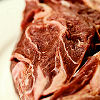
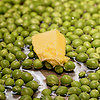
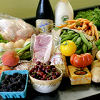
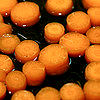

Quick & Tender Vegetables
– adapted from Staff Meals at Chanterelle
Trim and/or peel the vegetables into uniform shapes. (Shell peas; slice carrots into 1/3-inch-thick rounds; trim the stem end off green beans, etc.)
Place the prepped vegetables in a skillet large enough to stack them no more than two pieces deep; a single layer is even better. (If you’re combining different shapes and textures, like shelled peas and carrot rounds, it’s best to cook them in two separate pans, so you can adjust temperatures and timing as needed.) Add cold water to reach halfway up the vegetables — no more! — then add as big a hunk of butter as you dare, and goodly amount of kosher salt.
 Place the pan over high heat and bring to a boil. Cook uncovered, shaking the pan (or using tongs for long items like beans) to fiddle with the vegetables as they cook, until they’re brightly colored and tender but still have a little bite. Lift the vegetables out of the pan with tongs or a slotted spoon, letting them drip-dry just a bit, and place them in the serving dish.
Place the pan over high heat and bring to a boil. Cook uncovered, shaking the pan (or using tongs for long items like beans) to fiddle with the vegetables as they cook, until they’re brightly colored and tender but still have a little bite. Lift the vegetables out of the pan with tongs or a slotted spoon, letting them drip-dry just a bit, and place them in the serving dish.
locavore, One Local Summer, recipes
11 Comments »




 I first read about ‘nduja — a red-hot Italian meat paste that’s pronounced “en-DOO-ya” — in Saveur magazine, ages ago. Despite being the sort of foodstuff that’s right up my alley (hello, chiles and pork… together?!), I never seemed to be able to put my hands on the stuff. We’d heard rumors of a stall at London’s Borough Market selling ‘nduja, but our travels there never seemed to line up with their production. It seemed we’d have to make a trip to Calabria for the real thing, or go without.
I first read about ‘nduja — a red-hot Italian meat paste that’s pronounced “en-DOO-ya” — in Saveur magazine, ages ago. Despite being the sort of foodstuff that’s right up my alley (hello, chiles and pork… together?!), I never seemed to be able to put my hands on the stuff. We’d heard rumors of a stall at London’s Borough Market selling ‘nduja, but our travels there never seemed to line up with their production. It seemed we’d have to make a trip to Calabria for the real thing, or go without. This recipe is our entry for the inaugural week of One Local Summer 2009, hosted by Farm to Philly, with Western Region posts graciously recapped by Columbus Foodie. Just like last year, we’ll be exploring and honoring the foods from our local farmers and producers with at least one meal each week made from 100% local ingredients. We’re not declaring any exemptions this time — other than salt and spices — and our radius will be 100 miles.
This recipe is our entry for the inaugural week of One Local Summer 2009, hosted by Farm to Philly, with Western Region posts graciously recapped by Columbus Foodie. Just like last year, we’ll be exploring and honoring the foods from our local farmers and producers with at least one meal each week made from 100% local ingredients. We’re not declaring any exemptions this time — other than salt and spices — and our radius will be 100 miles.


























































